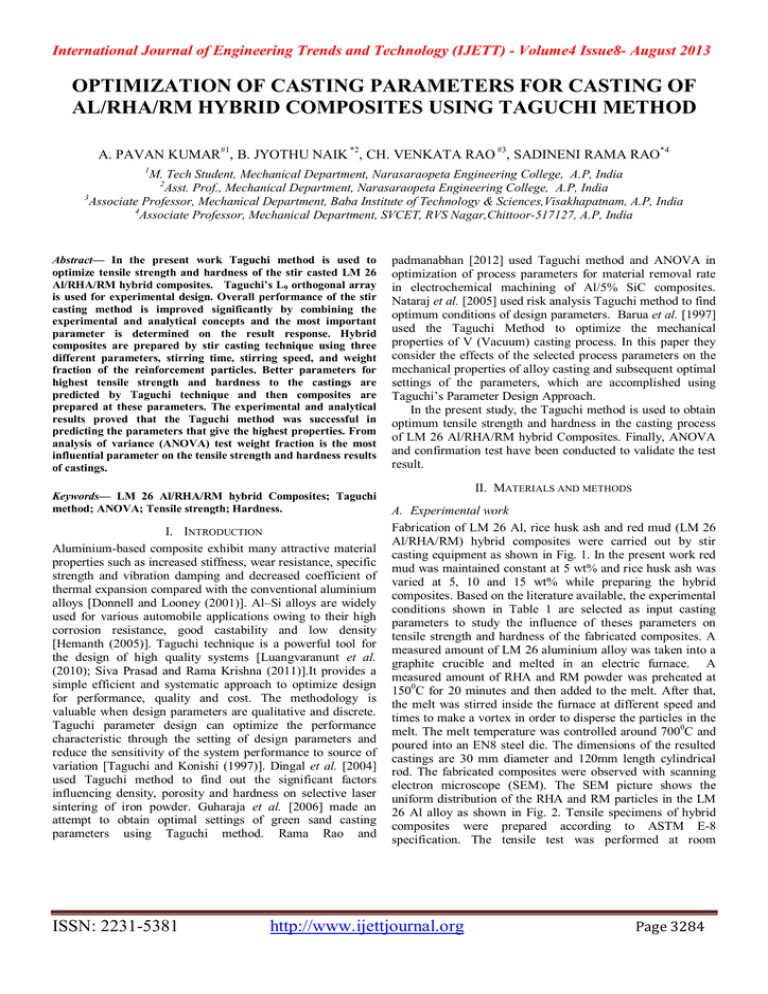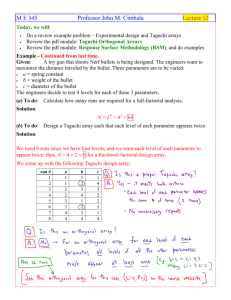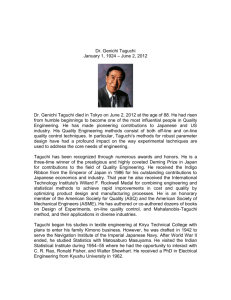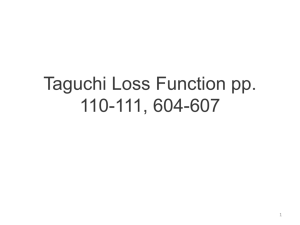OPTIMIZATION OF CASTING PARAMETERS FOR CASTING OF
advertisement

International Journal of Engineering Trends and Technology (IJETT) - Volume4 Issue8- August 2013 OPTIMIZATION OF CASTING PARAMETERS FOR CASTING OF AL/RHA/RM HYBRID COMPOSITES USING TAGUCHI METHOD A. PAVAN KUMAR#1, B. JYOTHU NAIK *2, CH. VENKATA RAO #3, SADINENI RAMA RAO*4 1 M. Tech Student, Mechanical Department, Narasaraopeta Engineering College, A.P, India 2 Asst. Prof., Mechanical Department, Narasaraopeta Engineering College, A.P, India 3 Associate Professor, Mechanical Department, Baba Institute of Technology & Sciences,Visakhapatnam, A.P, India 4 Associate Professor, Mechanical Department, SVCET, RVS Nagar,Chittoor-517127, A.P, India Abstract— In the present work Taguchi method is used to optimize tensile strength and hardness of the stir casted LM 26 Al/RHA/RM hybrid composites. Taguchi’s L9 orthogonal array is used for experimental design. Overall performance of the stir casting method is improved significantly by combining the experimental and analytical concepts and the most important parameter is determined on the result response. Hybrid composites are prepared by stir casting technique using three different parameters, stirring time, stirring speed, and weight fraction of the reinforcement particles. Better parameters for highest tensile strength and hardness to the castings are predicted by Taguchi technique and then composites are prepared at these parameters. The experimental and analytical results proved that the Taguchi method was successful in predicting the parameters that give the highest properties. From analysis of variance (ANOVA) test weight fraction is the most influential parameter on the tensile strength and hardness results of castings. Keywords— LM 26 Al/RHA/RM hybrid Composites; Taguchi method; ANOVA; Tensile strength; Hardness. I. INTRODUCTION Aluminium-based composite exhibit many attractive material properties such as increased stiffness, wear resistance, specific strength and vibration damping and decreased coefficient of thermal expansion compared with the conventional aluminium alloys [Donnell and Looney (2001)]. Al–Si alloys are widely used for various automobile applications owing to their high corrosion resistance, good castability and low density [Hemanth (2005)]. Taguchi technique is a powerful tool for the design of high quality systems [Luangvaranunt et al. (2010); Siva Prasad and Rama Krishna (2011)].It provides a simple efficient and systematic approach to optimize design for performance, quality and cost. The methodology is valuable when design parameters are qualitative and discrete. Taguchi parameter design can optimize the performance characteristic through the setting of design parameters and reduce the sensitivity of the system performance to source of variation [Taguchi and Konishi (1997)]. Dingal et al. [2004] used Taguchi method to find out the significant factors influencing density, porosity and hardness on selective laser sintering of iron powder. Guharaja et al. [2006] made an attempt to obtain optimal settings of green sand casting parameters using Taguchi method. Rama Rao and ISSN: 2231-5381 padmanabhan [2012] used Taguchi method and ANOVA in optimization of process parameters for material removal rate in electrochemical machining of Al/5% SiC composites. Nataraj et al. [2005] used risk analysis Taguchi method to find optimum conditions of design parameters. Barua et al. [1997] used the Taguchi Method to optimize the mechanical properties of V (Vacuum) casting process. In this paper they consider the effects of the selected process parameters on the mechanical properties of alloy casting and subsequent optimal settings of the parameters, which are accomplished using Taguchi’s Parameter Design Approach. In the present study, the Taguchi method is used to obtain optimum tensile strength and hardness in the casting process of LM 26 Al/RHA/RM hybrid Composites. Finally, ANOVA and confirmation test have been conducted to validate the test result. II. MATERIALS AND METHODS A. Experimental work Fabrication of LM 26 Al, rice husk ash and red mud (LM 26 Al/RHA/RM) hybrid composites were carried out by stir casting equipment as shown in Fig. 1. In the present work red mud was maintained constant at 5 wt% and rice husk ash was varied at 5, 10 and 15 wt% while preparing the hybrid composites. Based on the literature available, the experimental conditions shown in Table 1 are selected as input casting parameters to study the influence of theses parameters on tensile strength and hardness of the fabricated composites. A measured amount of LM 26 aluminium alloy was taken into a graphite crucible and melted in an electric furnace. A measured amount of RHA and RM powder was preheated at 1500C for 20 minutes and then added to the melt. After that, the melt was stirred inside the furnace at different speed and times to make a vortex in order to disperse the particles in the melt. The melt temperature was controlled around 7000C and poured into an EN8 steel die. The dimensions of the resulted castings are 30 mm diameter and 120mm length cylindrical rod. The fabricated composites were observed with scanning electron microscope (SEM). The SEM picture shows the uniform distribution of the RHA and RM particles in the LM 26 Al alloy as shown in Fig. 2. Tensile specimens of hybrid composites were prepared according to ASTM E-8 specification. The tensile test was performed at room http://www.ijettjournal.org Page 3284 International Journal of Engineering Trends and Technology (IJETT) - Volume4 Issue8- August 2013 temperature on a Universal Testing Machine of 10T (model Dak UTB9103). The hardness of each specimen is measured by using Vickers hardness apparatus type Zwick & Co., Germany. Fig.1. Stir casting equipment Table 1Control factors and levels Symbol Control factor A Stirring time (min) B Stirring speed (rpm) C Weight fraction of RHA (%) Level 1 Level 2 Level 3 6 9 12 100 200 300 5 10 15 B. Methodology In engineering analysis Taguchi methods have been utilizing for a long time for planning and conducting the experiments with the objective of acquiring data in a controlled way. The main advantage of Taguchi method is the saving of experimental time, reducing the cost, saving of effort in conducting experiments and discovering significant factors quickly. Taguchi’s robust design method is a powerful tool for the design of a high-quality system. In addition to the S/N ratio, a statistical analysis of variance (ANOVA) can be employed to indicate the impact of input process parameters on output response values. The steps applied for Taguchi optimization in this study are as follows. Select noise and control factors Select Taguchi orthogonal array Conduct Experiments Measurement of responses Analyze results (Signal-to-noise ratio and ANOVA) Predict optimum performance Confirmation experiment Taguchi method stresses the importance of studying the response variation using the signal – to – noise (S/N) ratio, resulting in minimization of quality characteristic variation due to uncontrollable parameter. The responses considered as the quality characteristic with the concept of "the larger-thebetter". The S/N ratio used for this type response is given as: S/N = −10 log (mean square deviation) ANOVA is a statistically based, objective decision-making tool for detecting any differences in the average performance of groups of items tested. ANOVA helps in formally testing the significance of all main factors and their interactions by comparing the mean square against an estimate of the experimental errors at specific confidence levels. First, the total sum of squared deviations from the total mean S/N ratio nm can be calculated as [Lindman (1992)]: where n is the number of experiments in the Fig. 2. SEM Picture of Hybrid AMMC ISSN: 2231-5381 orthogonal array and ni is the mean S/N ratio for the http://www.ijettjournal.org Page 3285 International Journal of Engineering Trends and Technology (IJETT) - Volume4 Issue8- August 2013 ith experiment. The percentage contribution P can be calculated as: Table 3 S/N ratios of tensile strength and Vickers hardness values Tensile strength Vickers hardness Level A B C A B C 1 44.73 45.31 44.26 38.60 38.70 38.06 III. RESULTS AND DISCUSSIONS 2 45.25 45.11 45.18 38.71 38.78 38.72 A. S/N ratio analysis The design matrix, tensile strength and Vickers hardness 3 45.40 44.95 45.94 38.87 38.71 39.40 Delta 0.67 0.37 1.68 0.27 0.08 1.34 Rank 2 3 1 2 where is the sum of the squared deviations. values of the LM 26 Al/RHA/RM hybrid composites prepared with different stirring speeds, stirring times and weight 3 1 fraction are given in Table 2. The S/N ratio values for tensile strength and Vickers hardness are calculated by taking into consideration “Eq. 1” and presented in Table 2. The measured responses were analyzed by using a standard commercial Fig. 3 shows the effect of the casting parameters on the tensile strength values. From Fig. 3 it is observed that the tensile strength of the composites increases with increase in stirring time and weight fraction of reinforced particles and decreases with increase in stirring speed. statistical software package MINITAB 14. Table 2 Design matrix and experimental observations Exp. No. A 1 1 2 1 3 1 4 2 5 2 6 2 7 3 8 3 9 3 The tensile B C TS (MPa) S/N ratio HV (N/mm2) 50 5 158 43.97 150 10 175 44.86 250 15 185 45.34 50 15 188 45.48 150 5 199 45.98 250 10 164 44.30 50 10 211 46.49 150 15 168 44.51 250 5 182 45.20 strength response table for the S/N ratio 78 37.84 86 38.69 92 39.28 86 38.69 93 39.37 80 38.06 95 39.55 82 38.28 87 38.79 stirring time, stirring speed and weight fraction was created in the integrated manner and the results are given in Table 3. Regardless of the category of the performance characteristics, a greater S/N value corresponds to a better performance. Therefore, the optimal level of the casting parameters is the level with the greatest S/N value. Based on the analysis of the S/N ratio, the optimal casting parameters for maximizing the tensile strength was obtained at 12 min stirring time (level 3), 100 rpm stirring speed (level 1) and 15 % weight fraction of Fig. 3. Effect of casting parameters on Tensile Strength The Vickers hardness response table for the stirring time,stirring speed and weight fraction was created in the integrated manner and the results are also given in Table 3. Based on the analysis of the S/N ratio, the optimal casting parameters for maximizing the hardness values was obtained at 12 min stirring time (level 3), 200rpm stirring speed (level 2) and 15 % weight fraction of reinforcement (level 3). Fig. 4 shows the effect of the casting parameters on the tensile strength values. reinforcement (level 3). ISSN: 2231-5381 http://www.ijettjournal.org Page 3286 International Journal of Engineering Trends and Technology (IJETT) - Volume4 Issue8- August 2013 Table 5 ANOVA results for Vickers hardness values Fig. 4. Effect of casting parameters on Hardness Values B. Analysis of variance ANOVA results for tensile strength are given in Table 4. ANOVA helps in formally testing the significance of all main factors and their interactions by comparing the mean square against an estimate of the experimental errors at specific confidence levels. The predicted R2 of 0.99 is in reasonable agreement with the adjusted R2 of 0.96. It can observed from Table 4 that the stirring time (A), stirring speed (B) and weight fraction of reinforced particles (C) affect the tensile strength by 14.6%, 4.9% and 79.5% in stir casting of LM 26 Al/RHA/RM hybrid composites. Source DF Seq SS Adj SS Adj MS Fvalue Pvalue Percent age (%) A 2 10.889 10.889 5.444 7.00 0.125 3.9 B 2 0.889 0.889 0.444 0.57 0.636 0.3 C 2 266.889 266.889 133.444 171.57 0.006 95.24 Error 2 1.556 1.556 0.778 Total 8 280.222 C. Conformation test In Taguchi’s design approach experimental confirmation test is the final step to verify the results. The optimal conditions are set for the significant factors (the insignificant factors are set at economic levels) and a selected number of experiments are run under specified cutting conditions. The confirmation experiment is a crucial step and is highly recommended by Taguchi to verify the experimental results [Ross (1996)]. In this study, a confirmation experiment was conducted by utilizing the levels of the optimal casting Table 4 ANOVA results for tensile strength parameters A3B1C3 for tensile strength and A3B2C3 for DF Seq SS Adj SS Adj MS A 2 337.56 337.56 168.78 14.75 0.064 14.6 B 2 113.56 113.56 56.78 4.96 0.168 4.9 C 2 1838.89 1838.89 919.44 80.34 0.012 79.5 Error 2 22.89 22.89 11.44 Total 8 2312.89 Source Fvalue Pvalue Percent age (%) hardness value in the casting of LM 26 Al/RHA/RM hybrid composites. The confirmation experiments results are given in Table 6. From Table 6 it is observed that the error between the prediction confirmation values of tensile strength and Vickers hardness is very. Table 6 Results of confirmation tests for tensile strength and hardness value ANOVA results for Vickers hardness values are given in Table 5. The predicted R2 of 0.9944 is in reasonable agreement with the adjusted R2 of 0.9778. It can observed from Table 5 that the stirring time (A), stirring speed (B) and weight fraction of reinforced particles (C) affect the hardness value by 3.9%, 0.3% and 95.24% in stir casting of LM 26 Al/RHA/RM hybrid composites. ISSN: 2231-5381 Optimal casting parameters Tensile strength Hardness value Prediction Confirmation Prediction Confirmation A3B1C3 A3B1C3 A3B2C3 A3B2C3 218 220 82 82 http://www.ijettjournal.org Page 3287 International Journal of Engineering Trends and Technology (IJETT) - Volume4 Issue8- August 2013 IV. CONCLUSIONS This work has discussed the application of the Taguchi method for investigating the effects of casting parameters on mechanical properties of LM 26 /RHA/RM hybrid composites prepared by stir casting technique. From the analysis of the results in the casting process using the conceptual signal-tonoise (S/N) ratio approach, analysis of variance (ANOVA), and Taguchi’s optimization method, the following can be concluded from the present study: The optimum level of casting parameters to obtain good tensile strength for stir casting of L26 /RHA/RM hybrid composites are 15% weight fraction of particles, 12 min stirring time, and 100 rpm stirring speed. The optimum level of casting parameters to obtain good hardness for stir casting of L26 /RHA/RM hybrid composites are 15% weight fraction of particles, 12 min stirring time, 200 rpm stirring speed for hardness. Weight fraction of reinforced particles has the major effect on the mechanical properties of L26 /RHA/RM hybrid composites. Taguchi method has proved its success in prediction the optimum casting parameters to reach the best properties. ISSN: 2231-5381 REFERENCES [1] Barua, P.B.; Kumar, P.; Gaindhar, J.L. (1997): Optimization of mechanical properties of V-Process castings by Taguchi method. Indian Foundry Journal, 18(3), pp. 17–25. [2] Dingal, S.; Pradhan, T.R.; Sundar, S,; Roy C.A.; Roy S.K. (2004): Experimental investigation of selective laser sintering of iron powder by application of Taguchi method. In: Proceedings of the Laser Assisted Net Shape Engineering conference LANE, Erlangen, Germany, pp. 445–456. [3] Donnell, G.O.; Looney, L. (2001): Production of aluminium matrix composite components using conventional PM technology. Material Science Engineering A, 303, pp. 292–301. [4] Guharaja, S.; Noorulhaq, A. (2006): Optimization of green sand casting process parameters by using Taguchi’s method. International Journal of Advanced Manufacturing Technology, 30(11), pp. 1040–1048. [5] Hemanth, J. (2005): Tribological behavior of cryogenically treated B4Cp/Al-12%Si composites. Wear, 258, pp. 1732–1744. [6] Lindman, H. (1992): Analysis of variance in experimental design, Springer-Verlag, New York. [7] Luangvaranunt, T.; Dhadsanadhep, C.; Umeda, J.; Nisaratanaporn, E.; Kondoh, K. (2010): Aluminum-4 mass%Copper/Alumina Composites Produced from Aluminum Copper and Rice Husk Ash Silica Powders by Powder Forging. Materials Transactions, 51(4), pp. 756-761. [8] Nataraj, M.; Arunachalam, V.P. (2005): Using risk analysis and Taguchi’s method to find optimal conditions of design parameters: a case study. . International Journal of Advanced Manufacturing Technology, 27(5), pp. 445–454. [9] Rama Rao, S.; and Padmanabhan, G. (2012): Application of Taguchi methods and ANOVA in optimization of process parameters for metal removal rate in electrochemical machining of Al/5%SiC composites, International Journal of Engineering Research and Applications, 2(3), pp. 192-197. [10] Ross, P.J. (1996): Taguchi techniques for quality engineering, McGrawHill International Editions, Singapore. [11] Siva Prasad, D.; Rama Krishna, A. (2011): Production and Mechanical Properties of A356.2 /RHA Composites. International Journal of Advanced Science and Technology, 33, pp. 51-58. [12] Taguchi, G.; Konishi, S. (1997): Taguchi methods, orthogonal arrays and linear graphs, tools for quality engineering, Dearborn, M I: AmericanSupplierInstitute,pp.35–38. http://www.ijettjournal.org Page 3288






